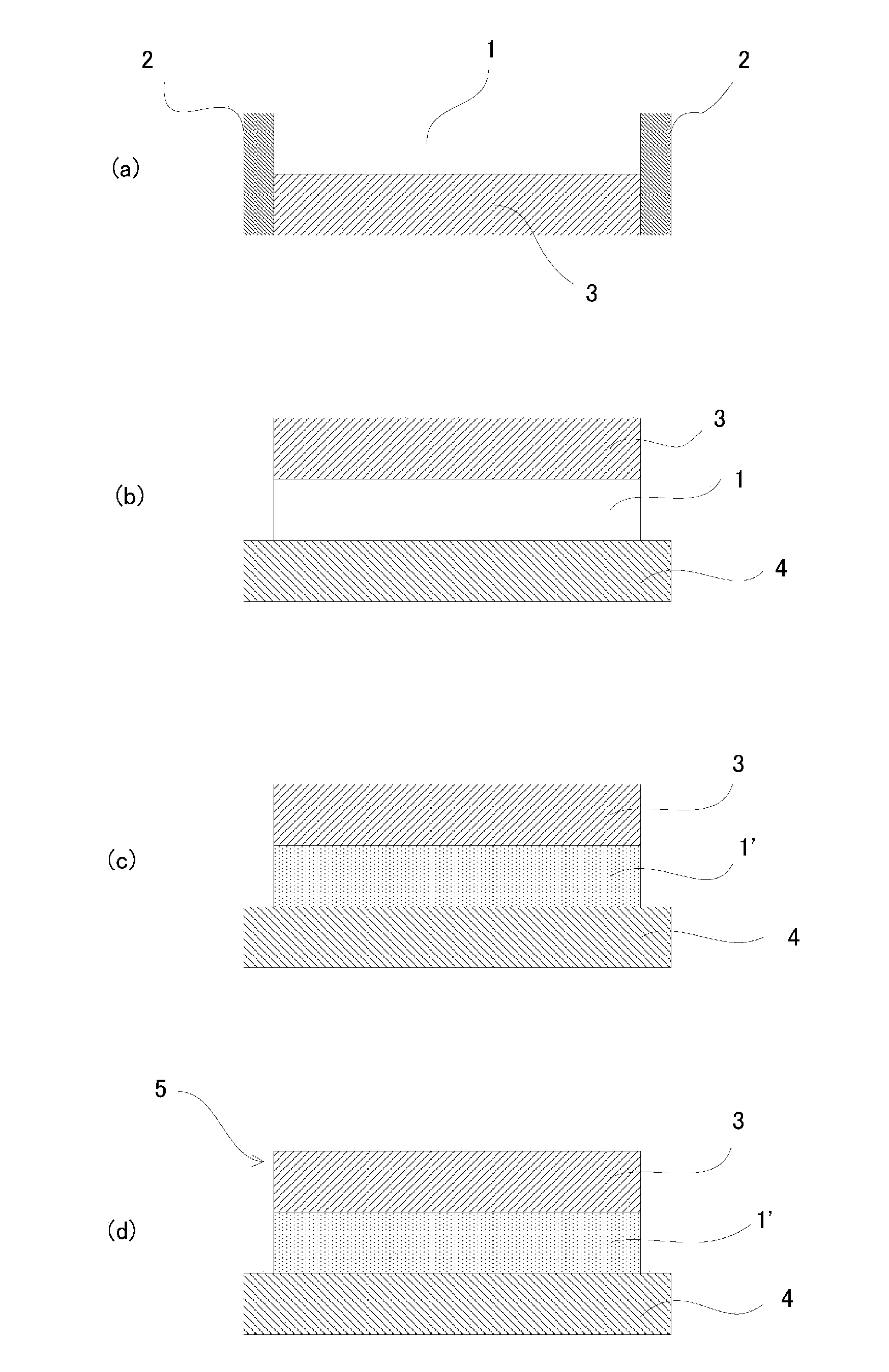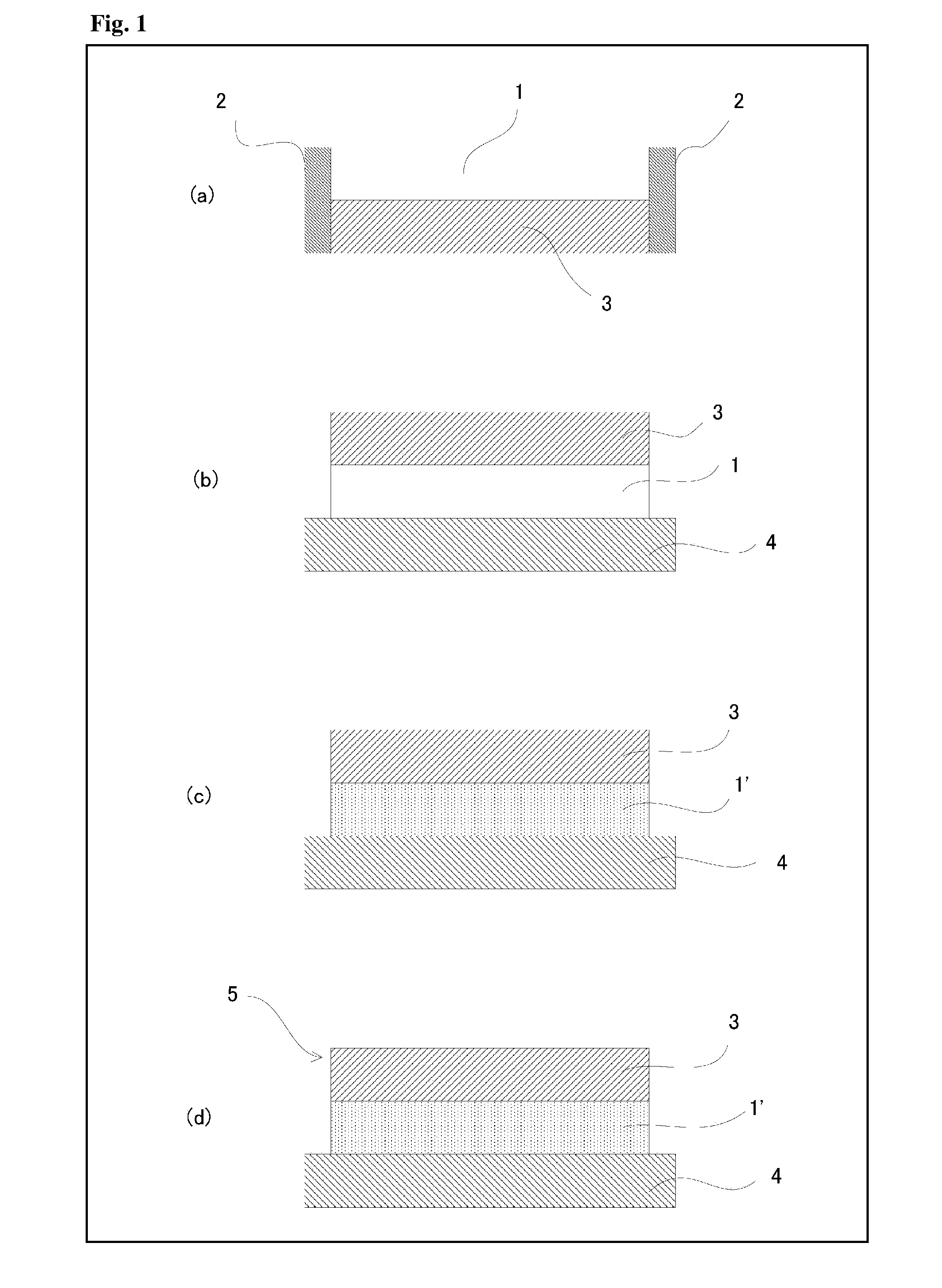Conductive paste and method for producing a semiconductor device using the same
a technology of conductive paste and semiconductor, which is applied in the direction of solid-state devices, non-conductive materials with dispersed conductive materials, basic electric elements, etc., can solve the problems of poor bonding strength of the paste, reduced glass phase which satisfactorily wets the surface of the adherend, etc., to achieve improved heat resistance and high electrical conductive properties
- Summary
- Abstract
- Description
- Claims
- Application Information
AI Technical Summary
Benefits of technology
Problems solved by technology
Method used
Image
Examples
examples
[0128]The glass frit is first described below. The glass frit used in the conductive paste of the present invention is not limited by the following Examples.
[0129][Glass Frit]
[0130]Table 1 shows a glass frit substantially comprising Ag2O (B-1), V2O5 (B-2), and MoO3 (B-3), and a glass frit substantially comprising Ag2O (B-1), V2O5 (B-2), MoO3 (B-3), and ZnO (B-4). Table 2 shows a glass frit substantially comprising Ag2O (B-1), V2O5 (B-2), MoO3 (B-3), and one oxide (B-4) of TiO2, MgO, Nb2O5, BaO, Al2O3, SnO, and Fe2O3. Table 3 shows a glass frit substantially comprising Ag2O (B-1), V2O5 (B-2), MoO3 (B-3), and CuO (B-4), and a glass frit substantially comprising Ag2O (B-1), V2O5 (B-2), MoO3 (B-3), ZnO (B-4), and CuO (B-4′). In Tables 1 to 3, the values shown for components (B-1) to (B-4) are expressed in % by mass.
[0131]The method for producing the glass frit is as follows.
[0132]As raw materials for the glass frit, oxide powders shown in Tables 1 to 3 were weighed and mixed together, a...
examples 9 to 14
[0157]Conductive pastes having the respective formulations shown in Table 7 were produced, and a thermal resistance (Rth) test was performed with respect to each of the produced conductive pastes to measure an electric resistivity, evaluating the electrical conductive properties. Further, with respect to each of the conductive pastes in Examples and Comparative Examples, a die shear stress (DSS) test was performed to measure a bond strength, evaluating the heat resistance.
[0158]FIG. 3 shows scanning electron microscope (SEM) photomicrographs of the silver particles used in Examples 9 to 14, taken at magnifications of 1,000 times, 2,000 times, and 5,000 times.
example 9
Production of a Conductive Paste (MP12-102-1)
[0159]Silver particles: P318-8, K-0082P (manufactured by Metalor Technologies Corporation); The mass ratio of P318-8 silver particles and K-0082P silver particles (P318-8:K-0082) is 50:50.
[0160]Glass frit: No. 25 (SC181-4); The specific surface area (Specific surface) of the glass frit measured by a BET method and the particle diameter of the glass frit measured by a laser diffraction-scattering method using MICROTRAC HRA9320-X100, manufactured by Nikkiso Co., Ltd., are shown in Table 6. With respect to glass frit No. 25, one obtained by grinding 100 g of the glass frit by means of a ball mill for 48 hours and subjecting the ground glass frit to sieve classification using a 400-mesh sieve was used. FIG. 4 shows scanning electron microscope (SEM) photomicrographs of glass frit No. 25 (SC181-4), taken at magnifications of (a) 1,000 times and (b) 500 times, wherein glass frit No. 25 was obtained after grinding by means of a ball mill for 48 ...
PUM
| Property | Measurement | Unit |
|---|---|---|
| mass ratio | aaaaa | aaaaa |
| temperature | aaaaa | aaaaa |
| boundary temperature | aaaaa | aaaaa |
Abstract
Description
Claims
Application Information
 Login to View More
Login to View More - R&D
- Intellectual Property
- Life Sciences
- Materials
- Tech Scout
- Unparalleled Data Quality
- Higher Quality Content
- 60% Fewer Hallucinations
Browse by: Latest US Patents, China's latest patents, Technical Efficacy Thesaurus, Application Domain, Technology Topic, Popular Technical Reports.
© 2025 PatSnap. All rights reserved.Legal|Privacy policy|Modern Slavery Act Transparency Statement|Sitemap|About US| Contact US: help@patsnap.com



